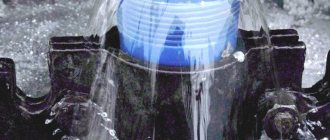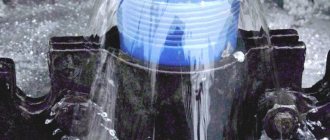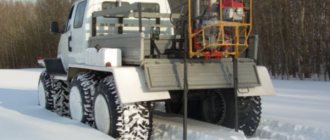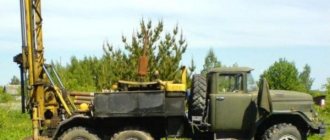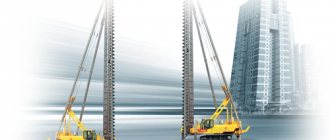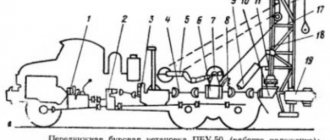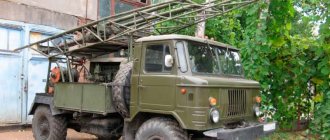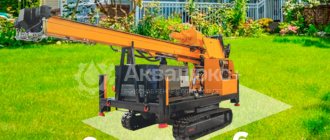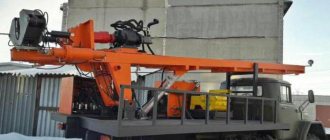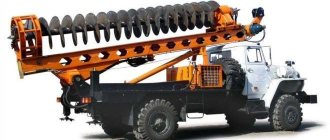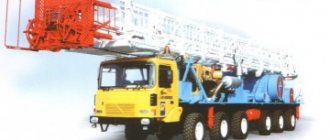Classification by drilling method
Based on this indicator, the following types of drilling rigs for drilling wells are distinguished:
- Rotary drilling machines. The technique makes a hole and destroys the soil using a special tool. It rotates and fits tightly to the face. The rock-cutting device can be a chisel or a reinforced crown. A similar technique is used for shallow drilling.
- Rotary percussion drilling machines. They act on the soil or rock by striking a tool that is constantly rotating. The rock cutting tool can be a crown or a chisel reinforced with reinforced inserts. A device of this type can be used to make wells up to 2000 meters deep.
- Impact drilling technology. It works on the basis of a falling projectile. Also, blows can be delivered to a projectile installed in the face.
- Installations with vibration drilling. The rock-cutting device is equipped with a column of drill pipes. Vibration load is transmitted through it. The vibration generator is a surface device, and the main element of the system is a vibration probe. Such machines can only be used when drilling rocks that are subject to physical compaction.
- Equipment for fire-jet drilling. The machine destroys the rock and makes a hole using high-temperature gas jets. Fire streams move at the speed of sound and are generated in the depths of a special burner. Devices of this type are used for soil and rocks with a crystalline base.
- Equipment for discharge-pulse drilling. The machines act on the soil with electrical discharges and can be used exclusively for deep compaction of rocks.
The impact drilling device is used to make holes in loose and soft rocks; in hard soils, the system can operate no deeper than 100 meters.
Drilling methods
Well development methods
The duration of the work process depends on the depth of the aquifer. Sometimes it lies at a depth of 10 m, and sometimes the well has to be deepened to several tens or even hundreds of meters. Each method has a specific setting. There are only four drilling methods:
- Rotary. The principle of rotation is used: the rotor ensures the rotation of the drill. Water (drilling fluid) is delivered inside the drill. It carries the sludge (crushed rock) out, while the drill remains in the well. It is gradually increased by installing additional rods. There are also rotary “dry” drilling units that operate without solutions. Such mechanisms require more effort, and the drilling speed is much lower. Rotary machines are used at shallow and medium depths - no more than 50 meters.
- Auger. Penetration into the soil occurs due to an auger - a rod with blades arranged as a screw. You can manually drill only two meters, for example, under a foundation on piles. But to get through a hard layer of clay or dense sand, you need to make a lot of effort. In this case, you will need a motor with a high torque - a rotor. The auger loosens the soil and brings it out. On soft soil, ordinary drills are used; on hard soil, drills with cutters are used; on rocky soil, augers are useless.
- Shock-rope. This method is used for drilling wells up to 300 meters. A heavy load is thrown into a well on a rope. The load consists of such components as a chisel, a rod, and a lock. Falling from a height, it crushes the soil, after which it is picked up and thrown again. The process is repeated until the barrel reaches the required length.
- Impact-rotational. Used for drilling mines to depths of 600 m and deeper. In this case, telescopic impact rods are used, as well as bentonite clay, thanks to which the walls of the shaft are strengthened. This method is used to develop not only wells for water, but also for oil production. The work process is ensured by mobile units located on a tractor or truck.
Using a shock-rotational installation, much less physical effort is spent. However, the design is quite complex and requires certain costs, since some parts will need to be purchased or made to order.
Division by type of work performed
In accordance with this criterion, well drilling installations are:
- Operational. The machines are used at the stage of rock exploration in a deposit. Their main purpose is to take soil samples to clarify geological data.
- Intelligence. This technique is used to collect soil samples from a field. Based on the results of his research, it is necessary to determine the significance of the industrial facility.
- For drilling technical wells. Holes are necessary in the construction of buildings and structures for various purposes, for the construction of foundations. They can also be classified as a type of oil and gas drilling rigs.
Drilling with flushing
This is the most effective way to develop a well up to 35 m deep, providing a penetration rate of up to 12 m/h. This figure significantly exceeds the performance of other methods. The process includes forward and reverse flushing of the well:
- With direct flushing, the solution enters the well to wash out the soil and release it to the surface.
- When reverse, the solution is also supplied to the barrel, but then the soil mass is pumped out using a pump.
The viscous flushing solution, in addition to cooling the cutting elements and clearing the well of rocks, performs another function - it strengthens the walls of the well, preventing them from collapsing, even if sandy or clayey soils are being developed.
By type of drive device
Drilling machines are:
- Electrical. The operation of the system is ensured by power from an electric generator or electrical network. Such machines are mainly used for making water wells for individual use.
- Electrohydraulic. The machines are used for drilling wells in hard soils. The main working mechanisms are a cone-shaped cylinder and a dielectric holder. The primary areas of equipment operation are construction, field exploration, and mining.
- Diesel-electric. A special feature of the machine is the independent operation of the main mechanisms. They are driven by an electric drive.
- Diesel. These machines are produced mainly in small sizes. They have a high degree of mobility, and their performance is ensured by a powerful diesel engine.
This equipment is capable of drilling wells for production and exploration work.
Percussion drilling
The principle of operation of such a mechanism is a sharp downward movement from the height of the pipe, at the end of which there is an impact cartridge. Under the influence of heavy weight, the soil is destroyed. Movement is carried out using a winch. After several blows with a bailer, the soil rises to the surface. After the procedure is completed, casing pipes are lowered into the formed well. They are necessary to eliminate the risk of side walls collapsing.
The structure consists of the following elements:
- block with tripod;
- rope;
- pointed pipe weighing up to 80 kg;
- bailer.
This method is labor-intensive, but it has several advantages:
- the possibility of one-time extraction of a large mass of soil;
- formation of a well or well of large diameter;
- high performance;
- the ability to carry out work in winter;
- long service life of the resulting structure.
However, there are also disadvantages:
- long duration of work in case of deep water;
- risk of soil collapse during well formation;
- the need to install casing pipes.
The equipment has special requirements: the cable must have a sufficient degree of strength and flexibility.
Classification by mode of transportation
Based on this criterion, drilling equipment can be:
- Self-propelled. It is equipped with a motor frame and a cabin. In other words, the installation is based on a heavy-duty vehicle.
- Mobile or mobile drilling rig. The modular structure of the installation is equipped with an individual mobile base.
- Stationary. The block system is equipped with elements for installation and reinforced supports.
Self-propelled drilling rig
The photo shows a mobile drilling rig
Stationary drilling rig
Drilling rig: features, characteristics
A drilling rig is a complex of mechanisms and structures designed to perform drilling operations. With the help of drilling rigs, wells are drilled for geological exploration purposes, for the extraction of minerals and access to underground water sources, for performing various works in construction. History of drilling rigs
Drilling mechanisms have been known since ancient times, but the first drilling rigs in the modern sense of the word were built in the mid-19th century for oil production. The first installations carried out impact drilling, from 1846 the technology of flushing wells with water began to be used, and from 1858 steam engines began to be used as a drive. In 1889, a rotary drilling mechanism was invented, which is still widely used in well drilling today. In the first half of the 20th century, mobile and self-propelled drilling rigs appeared, equipped on tractor and automobile chassis with internal combustion engines.
Classification and general structure of drilling rigs
Today there are the following types of drilling rigs:
- Stationary;
- Mobile (MDR) or mobile drilling rigs (PDU);
- Self-propelled (on a serial or special chassis).
Stationary installations are built for oil and gas production, for scientific research and for other purposes.
Such drilling rigs consist of many parts: drilling equipment located in the derrick, winches, pumps, and various auxiliary structures. Mobile or mobile units are, as a rule, equipment for water drilling, geological exploration, technical drilling, etc. Such equipment is divided into several groups:
- Manual installations (motor drills);
- Units for shallow drilling (hole drills);
- Trailer-mounted units;
- Units mounted on a chassis with an engine.
Self-propelled drilling rigs are a type of mobile drilling rigs that are mounted on a chassis (wheeled or tracked) with its own power unit.
Such installations can be manufactured on the basis of serial or special wheeled chassis, wheeled or tracked tractors and tractors, special tracked chassis. Structurally, mobile, self-propelled and small-sized drilling rigs for various purposes have much in common. The basis of the unit is drilling equipment of the impact, rotary or combined type, which is driven by its own engine or chassis power unit. The drilling equipment itself is mounted on a mast (truss, tubular or other type), which in the transport position is placed on the chassis, and in the working position is installed vertically or at an angle. To drive rotating equipment (crowns or augers), a special mechanism is used - a rotator. The installation also has a winch with a traverse and other auxiliary equipment.
Various parts can be used as working bodies in all drilling rigs: drill bits, augers and auger drills, bits and other impact projectiles. Various working elements can be used in one installation, which ensures the versatility of the machine.
Main characteristics of drilling rigs
The main characteristics of drilling rigs include:
- Drilling diameter;
- Drilling depth;
- Soil category;
- Special characteristics - casing diameter, feed force, feed stroke and others.
Modern drilling rigs have a maximum drilling diameter of up to 500 mm, for wells and other purposes - up to 800 - 900 mm.
The drilling depth ranges from several meters (hole drills, hand drills) to kilometers. Typical mobile and portable installations can drill wells up to 350 - 600 m deep in soils of the 1st - 4th category. Drilling rig manufacturers
In Russia, stationary drilling rigs are manufactured by Borets LLC, SpetsBurMash and other enterprises that supply individual components or systems. The leader in the production of mobile drilling rigs is JSC Geomash; also popular is the equipment of the Drilling Technologies Plant (St. Petersburg), JSC Kurganavtoremont, Lipetsk Plant of Small Utility Machines (LZMKM), Idel Neftemash (Bashkortostan), United drilling equipment plants named after V.V. Vorovsky" (Ekaterinburg) and others. The best known foreign drilling rigs are Bauer, Caterpillar, Liebherr, Komatsu, Soilmec, Casagrande, Tescar and others.
Interesting facts about drilling rigs
One of the most powerful mobile drilling rigs, model LB 44-510, is produced by the German company Liebherr. This machine is built on a tracked chassis, has a mass of 155 tons and can drill wells with a diameter of up to 3,000 m and a depth of up to 94.2 m.
Auger drilling
It is an inexpensive and convenient method, used on soft, sandy soils.
The device consists of the following parts:
- a drill or auger that is screwed into the ground;
- expandable bar;
- drive: manual or mechanized.
Using a drill located below, the device is screwed into the ground. The auger cutting parts loosen the soil. After some time, the rod with the tool rises to the surface and the waste is removed. If a greater manufacturing depth is required, the rod is gradually increased.
The advantages of this method include:
- speed of work;
- ease of installation installation;
- no need to attract qualified workers;
- maneuverability of equipment;
- work can be carried out in small areas.
A disadvantage is the shallow depth of the wells.

